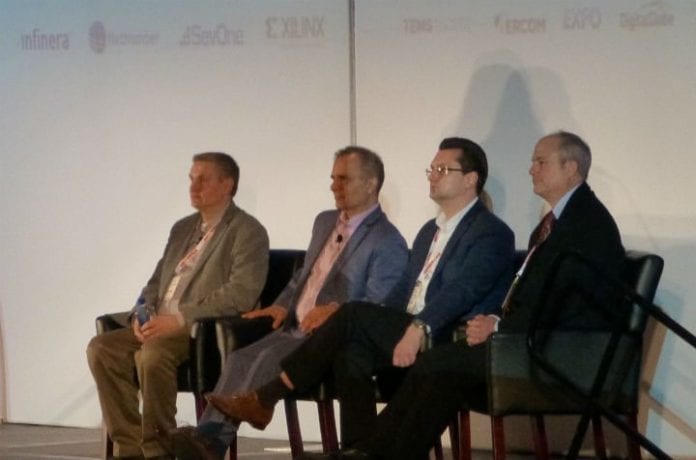Representatives from AT&T and Verizon continued to see fixed wireless broadband services as initial 5G deployment models.
DALLAS – The mobile telecom’s space push into “5G” technology was on center stage at this week’s 5G North America event, which officially kicked off with a keynote address and panel discussion looking at the current state of 5G.
During an early panel discussion on the topic, it was noted initial 5G deployments are expected to center on fixed broadband uses, where a carrier can use early technical specifications to power enhanced equipment able to support both higher data speeds and greater capacity.
Brian Daly, director of core and government and regulatory standards at AT&T, said AT&T was looking at such a move in order to get a handle on growing demand for video streaming services, noting video support was “probably one of the big use cases that we see,” with the carrier looking to take advantage of its diverse fixed, mobile and satellite assets in order to meet consumer demand.
Alexander Khalin, director of corporate strategy and development at Verizon Wireless, agreed on the initial deployment plans tied to fixed wireless broadband services.
One of the more controversial recent developments in the move towards 5G standards has been a perceived difference of opinion between Verizon Communications and AT&T in terms of timing for those standards.
AT&T is reported to have led a group at a recent standards meeting looking to get some form of 5G standards on the books by the end of 2017, which is well ahead of the Third Generation Partnership Project’s initial timeline of mid-2018. The move was explained by the carrier as it needing more time for testing some of the standards in order to be ready for further testing and commercial deployments by mid-2018.
Verizon Communications, which itself is seen by some as aggressively pushing its own 5G agenda tied to plans for network trials beginning in 2017, produced a counter-proposal stating it would like to keep the schedule as is. Khalin did not add any additional comments at this week’s event.
Daly explained AT&T was looking to get some form of standard committed between December 2017 and March 2018, which would be for a nonstandalone radio specification that could help inform silicon vendors as they prepare to develop early chipsets in support of network trials. The effort was mentioned under the guise of the carrier looking to ensure “learnings” from current and planned 5G network trials could be driven into the standards process.
Javan Erfanian, DMTS at Bell Canada, came to a similar conclusion, explaining there was so much to do in terms of 5G standards that it makes sense to push on certain aspects if possible.
“There is still so much to be done that we can’t let everything be done over time,” Erfanian said. “What can be done meaningfully and can be justified in the bounds of standards is a good thing.”
The nonstandalone model is expected to drive the first phase of 5G deployments, which would allow carriers that already have robust LTE networks to tap into those investments, including reuse of current evolved packet core as a control and user plane for 5G advances.
A reliance on current LTE deployments was also cited as important in terms of network coverage issues. Daly explained that with 5G networks looking at a heavy reliance on millimeter wave spectrum bands, services and use cases requiring broader coverage already supported by LTE deployments.
Daly also noted the reliance on higher frequency bands will require carriers to look at different technologies like advanced multiple-input/multiple-output and beamforming to track a device as it moves around and between cells due to challenging propagation characteristics.
Erfanian added while densification efforts are set to be a fundamental aspect of 5G network deployments, the industry will need to look at the process differently than in a 4G world. He explained densification is not just a linear progression of deploying small cells in order to match demand, but instead will become more complex in terms of matching small cell capabilities, spectrum resources and network integration.
“One thing alone will not help,” Erfanian said. “We need to look at all options.”
Chris Pearson, president of 5G Americas, added the industry would also need greater support from the government in terms of support for site deployments. Pearson cited a recent move by the European Union to look at so-called “permissionless” deployments,” though noted the U.S. was still far from such an idea.
“It’s not that we can’t get there, but we need to look as these different methods,” Pearson said.
Bored? Why not follow me on Twitter

